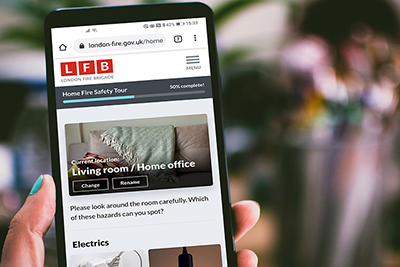What is it?
What is hoarding disorder?
The NHS summarises the problem well: "A hoarding disorder is where someone acquires an excessive number of items and stores them in a chaotic manner. The items can be of little or no monetary value and usually result in unmanageable amounts of clutter."
Hoarding disorder video
Fire safety and hoarding disorder
Understanding and reducing the risks
How can you reduce fire risks for hoarders?
Because of the amount of possessions, exit routes can become blocked, making safe evacuation more difficult. Fires can also spread much faster, especially where there are flammable items such as newspapers or cardboard.
Understand the risks
Hoarded materials can easily catch alight if they come into contact with heat sources such as overloaded extension leads, the kitchen hob or naked flames like candles or cigarettes. Because of the amount of possessions, fires will also spread much faster.
Fire safety suggestions
If you care for someone who lives in home that has become hoarded, you can help them live more safely by:
- Encouraging them not light candles or tea lights of any kind. A safer option is to use LED flameless candles.
- Ensuring they have appropriate heating so that they are not using portable heaters, candles or gas hobs to heat the home. If using portable heaters, ensuring that items aren't placed on top of, or too close to them.
- Suggest – or if you can, make sure – that they smoke outside if they are a smoker, never smoking in bed or where they could fall asleep, and that they use proper ashtrays.
- Contacting the Local Authority to discuss options for support to clear some of the clutter.
- Work with them to develop an escape plan.
- Book a home fire safety visit – a free service we offer to share advice and help.
Getting extra help
Want more advice?
There is a separate page for healthcare equipment including oxygen therapy, dynamic airflow pressure relieving mattresses and incontinence products. There's information about emollient creams here, and specialist advice to support smokers here.
Book a free home fire safety visit
We can also provide more specialist advice based on the person you care for's home and individual needs during a home fire safety visit.
They can be arranged 24/7, and we even fit free smoke alarms if the person you care for needs them. Specialist alarms can also be fitted – for example, strobe light and vibrating pad alarms for those who are deaf or hard of hearing.

Worried about someone you care for?
We have a simple tool that can guide you around the home helping you spot fire risks, or we can carry out a visit ourselves.
Extra information for formal and informal carers, support workers and other health care professionals
Carers, support workers and other health care professionals have access on a daily basis to people’s homes and living spaces. They play a vital role in the assessment of high risk individuals.
- If you are a formal carer, support worker or other healthcare professional, record and report your concerns to your line manager so an action plan can be put into place.
- If you are an informal carer, reduce any risks that you are able to, and notify other agencies such as Social Services to enable them to take swift and appropriate action as required.
- Use our online resources such as the Home Fire Safety Checker, or download the Checklist for Person Centred Fire Risk at the bottom of this page – this will help you identify areas of risk to the person you care for. You can also contact us to request an in-person Home Fire Safety Visit.
- If the person you care for or support is also in receipt of other care, or other agencies are also involved with them, do share your concerns so that you are all working together. Make sure that fire risk is included in the person’s care plan including things like using flame retardant bedding, appropriate management of emollient and skin creams, and how to care for people who smoke.
- Communicate with the person’s family or other supporting agencies to consider how Telecare can help to keep vulnerable people safer.
- Consider training to help you spot signs that may indicate the person you care for is at risk of injury from fire – and learn what steps you can take to reduce those risks.
Consider limited mobility
If the person you care for is bed bound or spends most of their time in a chair, they are particularly at risk. Please consider their needs and make sure appropriate measures are taken so they can safely escape if there is a fire. Learn more about escape plans from homes, and escape from workplaces (like residential care homes).
